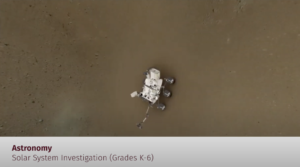
K-12 Virtual Programs at the Bell Reach New Audiences
Educators at the Bell Museum adapt to the changing needs of schools by creating virtual learning opportunities, furthering the Bell’s mission to be a museum without boundaries
Published12/29/2020 , by Emily Dzieweczynski
While virtual learning may cause us to be physically distant, the connections that we have with one another and the universe are no less abundant. Now more than ever, it is important to remind ourselves of these connections and to expand on them with education. This is why educators at the Bell are creating purposeful and innovative virtual K–12 programming that illuminates our connections with the universe and makes learning even more accessible to students across the state.
In fall 2020, the Bell’s virtual programs for K–12 classes launched with two different program pathways—natural history and astronomy. The programs were developed to support K–12 education standards and can be used for distance or in-class learning. During the programs, students interact with dedicated Bell educators and engage with topics ranging from the micro-societies of pollinators to the macrocosm of the solar system.

Understanding the needs of students and teachers who are impacted by remote learning, educators at the Bell responded by creating virtual learning options that are interactive and engaging. In the natural history programs, educators begin with interactive games that involve drawing, writing, questions for the students, and up-close looks at plant and animal specimens. During the astronomy programs, students become space explorers by using interactive polls and the chatbox to decide where in the universe to travel while on their virtual field trip through outer space. Many teachers have seen the impact that these adaptations have made and shared in their students’ excitement.
“My students were VERY engaged! The Bell Museum educator was enthusiastic, knowledgeable, and very personable! My students LOVED the activities—‘Guess What’s in the Box!,’ draw-the-MN-biomes, and encounters with the animals. My students were typing things in the chat like, ‘This is so fun!’ and their enthusiasm bubbled over for the rest of the day,” one teacher said.
In the astronomy pathway, Bell educators connect students to the universe by allowing their questions to guide the program. By responding to the specific interests that students bring to each session, Bell educators ensure that students’ wonder and curiosity are valued. For example, in a recent Life in the Universe class (grades 8–12), the educators focused on space crafts sent to Mars because of the questions raised by students. There is never a lack of insightful questions to guide the programs. Educators in the astronomy programs receive questions such as, “how many stars are there?” or “how did the solar system form?”
In the Bell’s natural history programs, educators also receive many exciting questions. In the Pollinator class (grades K–2), students wonder about why bees sting and how to help our pollinators. The Ecosystem Explorer class (grades 3–5) explores Minnesota’s biomes and the species that inhabit them. One student in the Biomimicry (grades 6–8) class even reported, “these people are Zoom experts, I love it!”
These creative adaptations allow Bell educators to better serve the new needs of remote learning classrooms while furthering the mission at the Bell. Kaitlin Ehret, the Bell’s planetarium outreach educator, commented on how the Bell’s original astronomy content has adapted in order to support this mission.
“We decided to provide the three shows that would best fit this new style of teaching and learning while still igniting curiosity and wonder in as many students as possible. We wanted to make sure we could provide meaningful and inspiring learning opportunities for as many students across Minnesota as we have in previous years with our astronomy programs,” she said.

The Bell strives to be a museum without boundaries and, in many ways, the virtual adaptation to K–12 educational programs has made this mission even more possible. Sarah Riemer, the Bell’s youth & family programs manager, has seen the impact these adaptations have had on reaching more curious minds across the state.
“The virtual format actually allows us to expand our reach and connect with schools that might not have been able to experience the Bell in person due to distance, transportation costs, or accessibility,” Reimer said.
In addition to the virtual format that makes the Bell’s programming more accessible, scholarships are being offered to schools where 50 percent of the student population receives free and/or reduced lunch. Participating in these dynamic programs has been made possible through generous support from Ruth and John Huss, Manitou Fund, and the Margaret Rivers Fund. At the Bell, we believe that there should be no barriers to students’ curiosity about science.
Curious? Check out the Bell’s virtual field trips.

